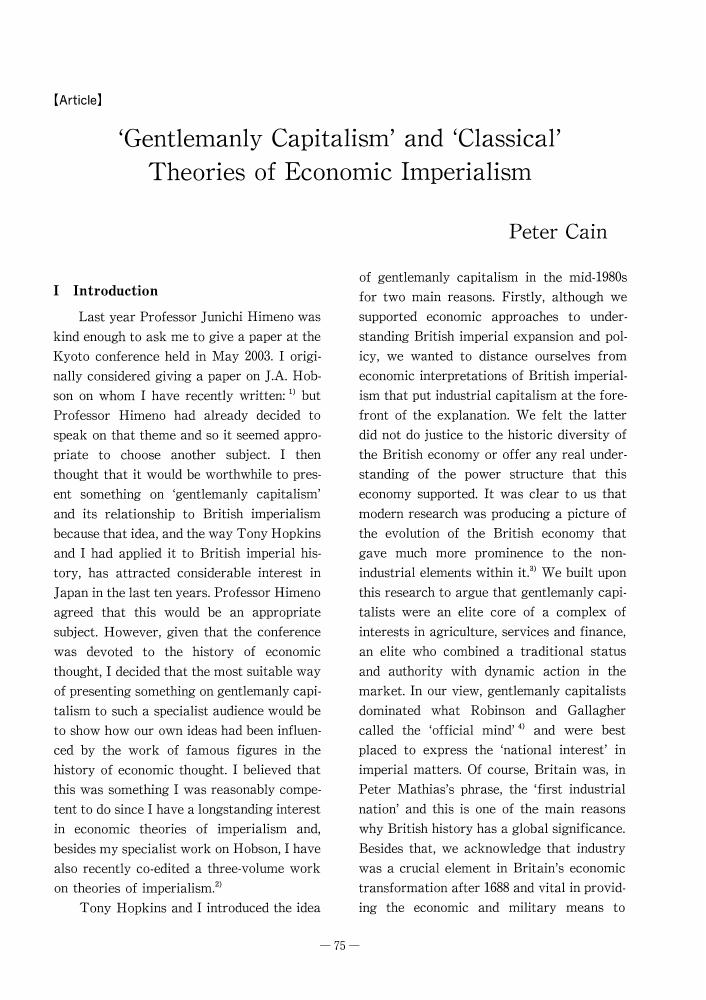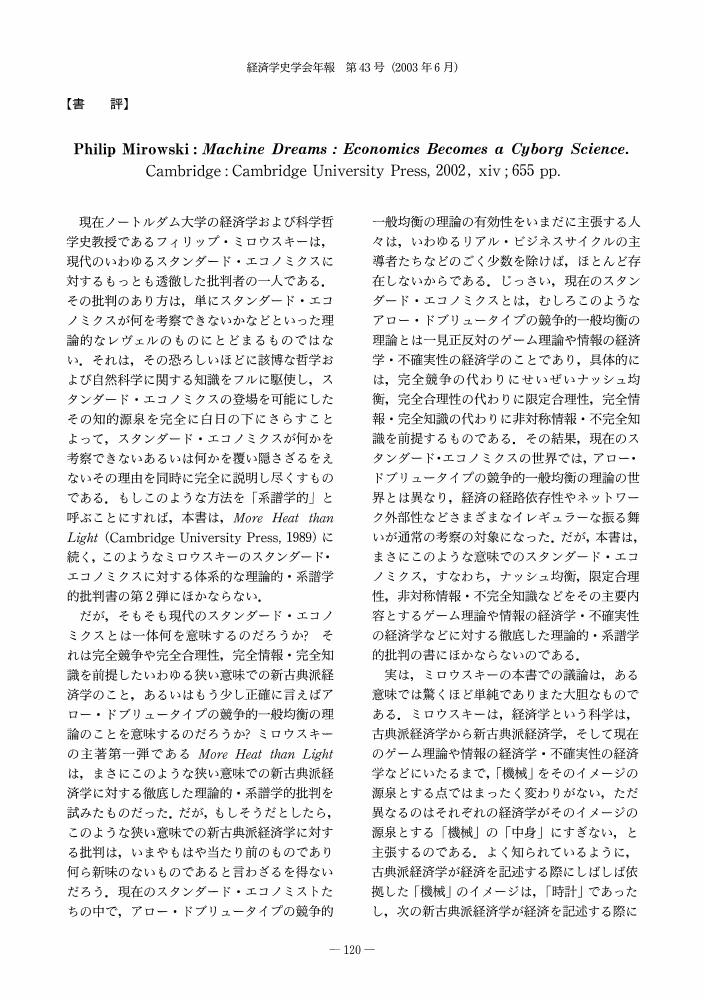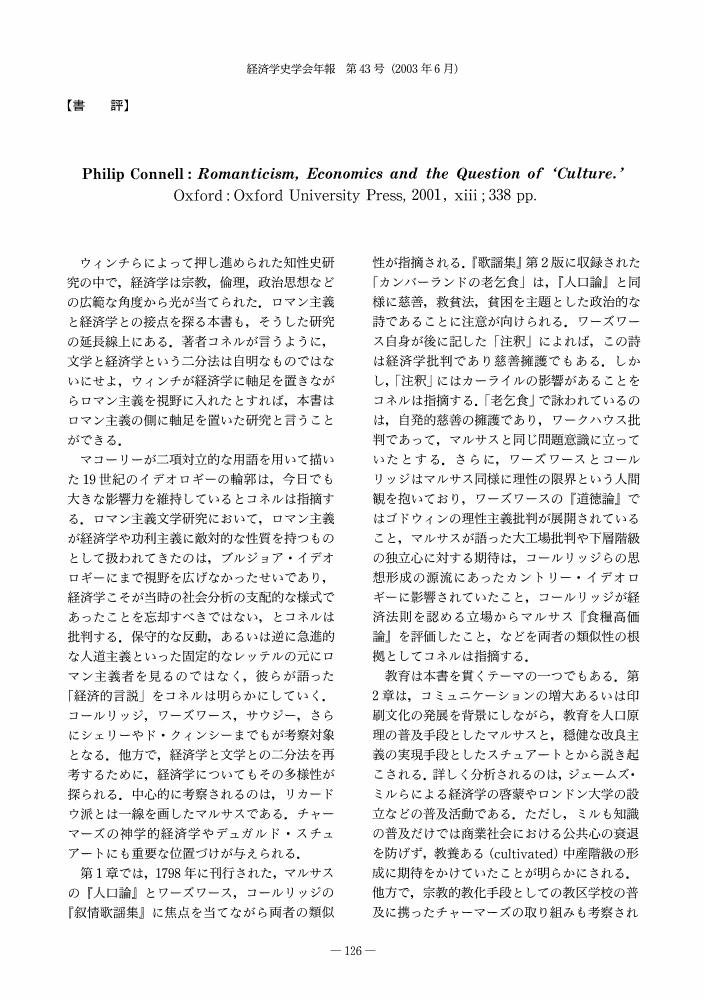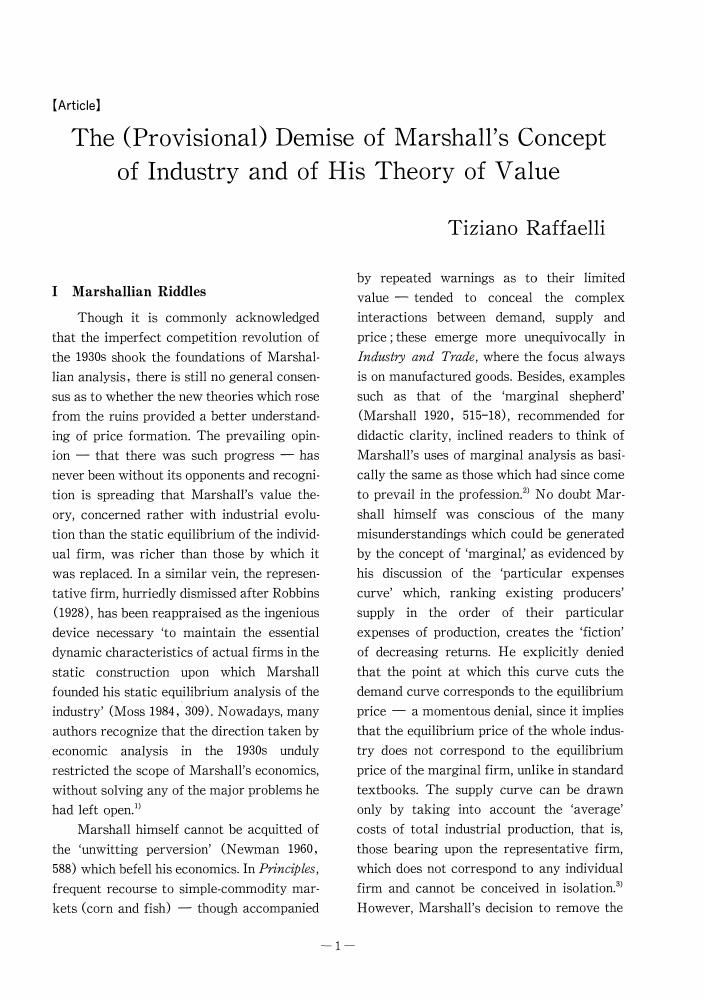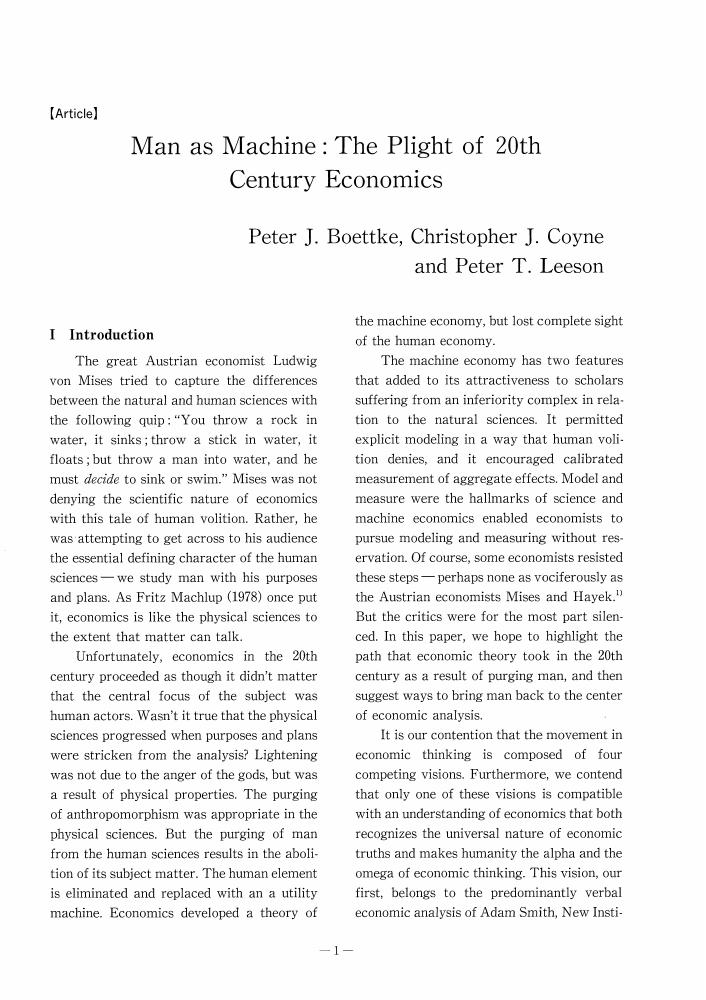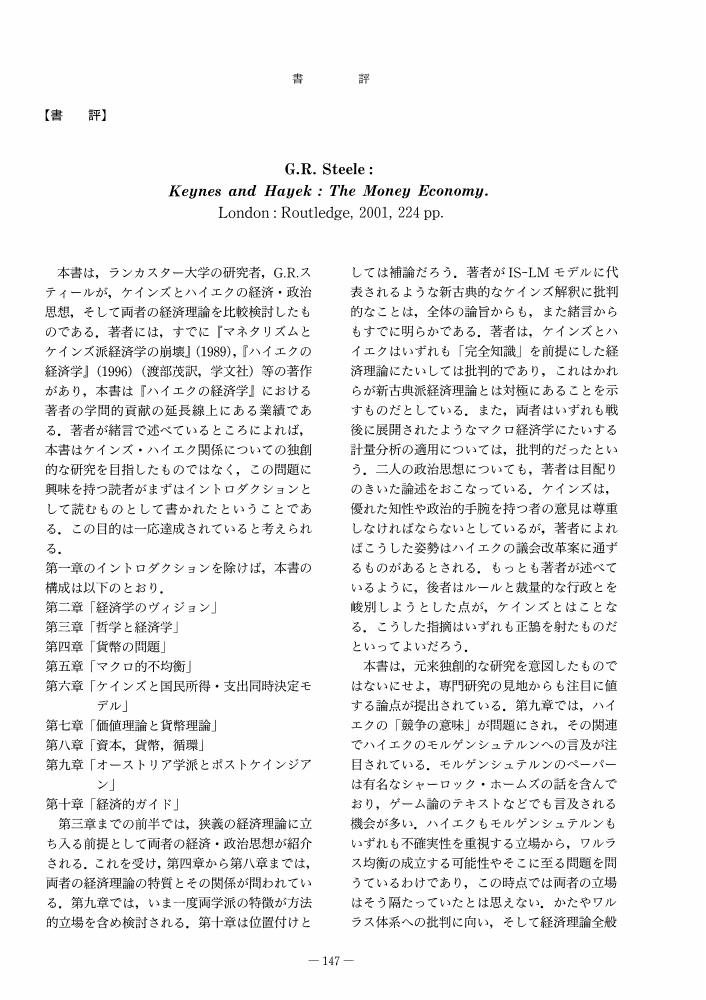- 著者
- Peter Cain
- 出版者
- The Japanese Society for the History of Economic Thought
- 雑誌
- 経済学史学会年報 (ISSN:04534786)
- 巻号頁・発行日
- vol.44, no.44, pp.75-83, 2003 (Released:2010-08-05)
1 0 0 0 OA 日本経済思想史: 経済政策思想と経済構想
- 著者
- 三島 憲之
- 出版者
- The Japanese Society for the History of Economic Thought
- 雑誌
- 経済学史学会年報 (ISSN:04534786)
- 巻号頁・発行日
- vol.44, no.44, pp.84-97, 2003 (Released:2010-08-05)
- 参考文献数
- 68
The purpose of this paper is to consider the direction of the future investigation by way of a review of the studies of the economic thought in the Meiji Period in the last twenty years.By studying the economic thought in the Meiji Period, generally not only the economists but also the thinkers, the journalists, the statesmen, the bureaucrats, and the entrepreneurs are made the object. As well, in regard to topics in the study of the Japanese economic thought of the age following the Meiji Restoration, we find at present a general consensus. If it is limited to he Meiji Period, the topics can be summarized as the following three approaches. The firs are studies that examine the so-called “continuance and severance” between the idea which allowed the reception of the Western political economy, and the economic thought in the Edo Period. The second are studies that intend to clarify the introduction of the Western political economy into Japan. The third are studies that aim to elucidate the process of the diffusion and the fixation of the Western political economy in Japan. In this paper, the first is called “the approach focusing on continuance and severance, ” the second is called “the approach focusing on the history of the introduction, ” while the third is called “the approach focusing on institutionalization.”In addition to those studies pursuing the above three lines of thought, there are studies that examine the economic policy ideas and the economic vision in the Meiji Period. This is called the “approach focusing on the history of the economic policy ideas.” This paper emphasizes the importance of the studies taking this point of view.Two ideas are fairly suggestive in the study talking the latter approach. One is “developmentalism.” This principle focuses on the nationalism of a backward country, industrialization under the governmental leadership, and the affirmation of governmental intervention in an economy. This can provide a conceptual framework for further study because its elements were widely contained in various economic policy ideas and economic visions appearing in the Meiji Period. The other one is the result of the more recent studies regarding the mercantilism. The authors of such studies insist on the following: Most political economy is structured in such a way that government can intervene to any degree in the market from the viewpoint of the public utility. And, free trade and protectionism often complement each other. If this view is accurate, the validity of the simple point of view in which free trade and protectionism confront each other must be reconsidered, this being true in the studies of the economic thought in the Meiji Period as well.
1 0 0 0 OA 古典派貨幣理論
- 著者
- 佐藤 有史
- 出版者
- The Japanese Society for the History of Economic Thought
- 雑誌
- 経済学史学会年報 (ISSN:04534786)
- 巻号頁・発行日
- vol.44, no.44, pp.98-113, 2003 (Released:2010-08-05)
- 参考文献数
- 76
Since late 1970's there has emerged a variety of ‘new’ interpretations of classical monetary theory, shedding new light on classical economists pace ‘old’ interpretations. They have indeed transformed our understanding of classical theory. Though there have already been several efforts to outline these ‘new’ interpretations: e. g., those of J. Niehans, M. C. Marcuzzo, A. Rosselli, N. T. Skaggs, and D. Glasner, they are far from monolithic, and indeed there are significant differences among their viewpoints. Unfortunately there has been no effort to comprehend ‘new’ interpretations, though several common grounds have been put forward to revise our understanding of classical theory as opposed to ‘old’ interpretations. It is time to synthesize and appraise the major findings of ‘new’ interpretations.In this review article I propose my own syntheses of ‘new’ interpretations as follows: (a) the theoretical framework of classical monetary theory was quite different from that of the quantity theory of money, while ‘old’ interpretations have often confused them, (b) classical economists had in fact developed a remarkable theory of monetary policy, while ‘old’ interpretations have failed to appreciate it since they have insisted in looking at classics through the ‘rules versus discretion’ lens, and (c) instead, the ‘central banking versus free banking’ controversy should be understood as one of the most crucial themes in appreciating the way in which classical economists sought to develop their own theories of money and banking, while almost all ‘old’ interpretations have neglected this aspect.Almost all the ‘new’ interpretations, including my own, have shared a broad agreement regarding thesis (a), though there are some differences, for example, regarding their attitudes to the monetary approach to the balance of payments, and its applicability to Adam Smith and David Ricardo. As for (b) and (c), there are differences, to which the modern free banking school has contributed. On the one hand, the modern free banking school, by highlighting the classical theory of commodity money, praises the Smithian-banking school tradition in favor of their case for free banking. In so doing, they put both Henry Thornton and Ricardo in a rather unhappy position. On the other hand, in their perceptive treatments of Ricardo's theory of money and monetary policy, Marcuzzo and Rosselli, and A. Arnon detect a rupture between Smith and the ‘true classical monetary theory’ of Thornton and/or Ricardo. I emphasize a continuity in the development of the classical theory of central banking from Smith to Ricardo via Thornton in that Smith played an important role in making the 1765 Act, banning small notes below f5 and optional clauses, which facilitated the Bank of England in his day to behave in the manner of a central bank. Moreover, it is Ricardo's plans both for ‘bullion payments’ and for the establishment of a national bank, a remarkable achievement of the classical theory of monetary policy, that makes the ‘old’ interpretations based on the ‘rules versus discretion’ distinction obsolete. I argue that there existed quite a coherent classical central banking tradition based on their insights into the fractional reserve banking system under the gold standard, rather than an alleged rupture between Smith and Thornton-Ricardo. I also emphasize that advocates for free banking in the classical era were in fact no match for the Smith-Thornton-Ricardo tradition.
- 著者
- 荒川 章義
- 出版者
- The Japanese Society for the History of Economic Thought
- 雑誌
- 経済学史学会年報 (ISSN:04534786)
- 巻号頁・発行日
- vol.43, no.43, pp.120-121, 2003 (Released:2010-08-05)
- 著者
- 鍋島 直樹
- 出版者
- The Japanese Society for the History of Economic Thought
- 雑誌
- 経済学史学会年報 (ISSN:04534786)
- 巻号頁・発行日
- vol.43, no.43, pp.122-123, 2003 (Released:2010-08-05)
- 著者
- 内山 隆司
- 出版者
- The Japanese Society for the History of Economic Thought
- 雑誌
- 経済学史学会年報 (ISSN:04534786)
- 巻号頁・発行日
- vol.43, no.43, pp.124-125, 2003 (Released:2010-08-05)
- 著者
- 柳沢 哲哉
- 出版者
- The Japanese Society for the History of Economic Thought
- 雑誌
- 経済学史学会年報 (ISSN:04534786)
- 巻号頁・発行日
- vol.43, no.43, pp.126-127, 2003 (Released:2010-08-05)
1 0 0 0 OA 『重商主義再考』に対する3つのコメント
- 著者
- 深貝 保則
- 出版者
- The Japanese Society for the History of Economic Thought
- 雑誌
- 経済学史学会年報 (ISSN:04534786)
- 巻号頁・発行日
- vol.43, no.43, pp.128-131, 2003 (Released:2010-08-05)
- 参考文献数
- 8
1 0 0 0 OA 『重商主義再考』に対する3つのコメント
- 著者
- 田中 秀夫
- 出版者
- The Japanese Society for the History of Economic Thought
- 雑誌
- 経済学史学会年報 (ISSN:04534786)
- 巻号頁・発行日
- vol.43, no.43, pp.131-133, 2003 (Released:2010-08-05)
- 参考文献数
- 1
1 0 0 0 OA 『重商主義再考』に対する3つのコメント
- 著者
- 柳澤 治
- 出版者
- The Japanese Society for the History of Economic Thought
- 雑誌
- 経済学史学会年報 (ISSN:04534786)
- 巻号頁・発行日
- vol.43, no.43, pp.133-137, 2003 (Released:2010-08-05)
- 参考文献数
- 5
- 著者
- Chikako Nakayama
- 出版者
- The Japanese Society for the History of Economic Thought
- 雑誌
- 経済学史学会年報 (ISSN:04534786)
- 巻号頁・発行日
- vol.43, no.43, pp.138-140, 2003 (Released:2010-08-05)
- 参考文献数
- 5
- 著者
- Tiziano Raffaelli
- 出版者
- The Japanese Society for the History of Economic Thought
- 雑誌
- 経済学史学会年報 (ISSN:04534786)
- 巻号頁・発行日
- vol.44, no.44, pp.1-16, 2003 (Released:2010-08-05)
- 参考文献数
- 70
- 著者
- 堂目 卓生
- 出版者
- The Japanese Society for the History of Economic Thought
- 雑誌
- 経済学史学会年報 (ISSN:04534786)
- 巻号頁・発行日
- vol.43, no.43, pp.116-117, 2003 (Released:2010-08-05)
- 著者
- 川俣 雅弘
- 出版者
- The Japanese Society for the History of Economic Thought
- 雑誌
- 経済学史学会年報 (ISSN:04534786)
- 巻号頁・発行日
- vol.43, no.43, pp.118-119, 2003 (Released:2010-08-05)
- 著者
- 御崎 加代子
- 出版者
- The Japanese Society for the History of Economic Thought
- 雑誌
- 経済学史学会年報 (ISSN:04534786)
- 巻号頁・発行日
- vol.42, no.42, pp.165-167, 2002 (Released:2010-08-05)
- 参考文献数
- 7
- 著者
- Peter J. Boettke Christopher J. Coyne Peter T. Leeson
- 出版者
- The Japanese Society for the History of Economic Thought
- 雑誌
- 経済学史学会年報 (ISSN:04534786)
- 巻号頁・発行日
- vol.43, no.43, pp.1-10, 2003 (Released:2010-08-05)
- 参考文献数
- 13
1 0 0 0 OA マーシャルの生産知識論
- 著者
- 藤井 賢治
- 出版者
- The Japanese Society for the History of Economic Thought
- 雑誌
- 経済学史学会年報 (ISSN:04534786)
- 巻号頁・発行日
- vol.43, no.43, pp.11-23, 2003 (Released:2010-08-05)
- 参考文献数
- 24
In this paper, we try to reinterpret Marshall's External Economies with the key con cept of “the knowledge on production methods.” In Section 2, through reexamining the criticism directed against Marshall's treatment of increasing returns, we outline the reason why we seek the possibility of “external economies at an industry level.” The consequence of the Cambridge Cost Controversy was quite legitimate as far as the adoption of the equilibrium method was premised. Marshall's representative firm cannot be supported when assessed strictly since it is a static concept that contains several dynamic forces in it. Surely, we need to adopt a dynamic method for dynamic phenomena, which Allen Young once maintained forcibly. But we differ from Young in that we consider a partial method to be useful in spite of the fact that he contended the analysis of increasing returns to be conducted in inter-industrial context.In Section 3, the function of the organization of a firm is discussed from the standpoint of “the knowledge on production methods, ” which is the type of applicable knowledge that cannot be discovered and learned from basic principles nor restored as explicit knowledge. The characteristic of the knowledge on production methods is that both improving and learning take place only gradually through a trial-and-error process. So, time and stable environments are necessary for this type of knowledge to be utilized effectively. We show that internal economies can be interpreted as the economies of specialization and integration of production knowledge at a firm level.In Section 4, we proceed to the reinterpretation of Marshall's external economies. What various firms in an industry face is the situation where the knowledge on the production methods is not in a complete form and is much diversified among them. Thus, an industry can be regarded as a place of competition over alternative production methods. Firms in an industry strive to improve their own knowledge while paying attention to the movements of other firms. Firms in the same industry can be viewed to comprise a kind of knowledge community where the knowledge on the production methods spreads and is shared. Although firms in the same industry are in a competitive relation, but are on the same vessel in another viewpoint. For, any progress in production methods carried out by one firm is a threat to others in the same industry in the short run, but contributes to the industry as a whole in the long run. The shared knowledge can contribute to unintended cooperation among firms that adopts the same production knowledge just as a commonly shared language does. Thus, standardization helps to economize coordination costs between firms in the same industry. The main contention of this paper is that Marshall's external economies can be reinterpreted as the economies available through the standardization of knowledge on production methods that takes place mainly at the industry level. Being reinterpreted in this way, Marshall's concept of external economies has a sufficient economic basis.
1 0 0 0 OA ジェイムズ・ステユアートの為替論
- 著者
- 古谷 豊
- 出版者
- The Japanese Society for the History of Economic Thought
- 雑誌
- 経済学史学会年報 (ISSN:04534786)
- 巻号頁・発行日
- vol.43, no.43, pp.24-37, 2003 (Released:2010-08-05)
- 参考文献数
- 25
In his doctrine of exchange, Steuart advanced a policy in which the exchange rate be kept at par by the state. He says that by a statesman's giving bills at par on all occasions, and being himself at the expense of transportation and insurance, in bringing home and sending off all balances, exchange would of itself come to par.Today it is widely accepted that this policy of Steuart's is only a temporary expedient. It is said that Steuart intended this policy as an emergency measure meant to avoid an evil effect of the strong sterling rate. The statesman must not intervene under normal occasions; it is allowed only when the balance of payments is in his favor, and the strong sterling rate discourages exportation.It is shown in this paper that this interpretation stems mainly from the following two factors. First, Steuart's theory is explained as a primitive equilibrium theory. Critics using this approach assert that Steuart's theory of political economy is fundamentally based on market mechanism, and that state intervention is allowed only as a temporary expedient. Second, they understood Steuart's term “high exchange” as “strong sterling rate, ” when Steuart points out that the “high exchange proves a prodigious discouragement to trade in general.”But as we see in this paper, Steuart used this term to refer to a large detachment of the exchange rate from the par. A strong sterling rate, therefore, is expressed as “a price of exchange in favour of a country, ” and a very weak sterling rate is expressed as “high exchange against a country.” According to Steuart, the problem was not the high sterling rate, but the large fluctuations of the exchange. The detachment of the exchange rate from the par, whether it be over or under the par, “produces an instability in the profits upon trade.” Thus Steuart concludes “that it is greatly for the interest of a trading state to keep exchange, at all times, as nearly at par as possible.” This exchange policy enables bills of exchange to circulate according to the true sterling value.The point I wish to emphasize in this paper is that this policy is a constituent of Steuart's monetary policy. Steuart regards bills of exchange as money, along with coins and bank notes. It holds true for bills, when Steuart states “It is of great consequence to a statesman to understand it (the doctrine of money) thoroughly; and it is of the last importance to trade and credit, that the money of a nation be kept stable and invariable.” Accordingly, Steuart enumerates this exchange policy, policy on coin, and policy on bank notes as three branches of “the whole policy of circulation.” In Steuart's theory of political economy, it is of great importance to appropriately supply circulation with stable and invariable money, and this doctrine of exchange must also be understood in this context.
1 0 0 0 OA ピグーの理想的功利主義の構造と厚生経済学
- 著者
- 山崎 聡
- 出版者
- The Japanese Society for the History of Economic Thought
- 雑誌
- 経済学史学会年報 (ISSN:04534786)
- 巻号頁・発行日
- vol.43, no.43, pp.38-51, 2003 (Released:2010-08-05)
- 参考文献数
- 38
This paper is intended as an investigation of the relation between Pigou's ethics and his welfare economics. For this purpose, I shall introduce the basic ethical knowledge that originated with J. S. Mill. This knowledge provides the structure of ethics. On the whole, ethical theory has three elements, which include the facts about moral phenomena, fundamental principles, and practical principles (criteria). As it seems that the first does not require further explanations but the latter two do, some comments shall be appended to each of the latter. First, the fundamental principle is the ultimate grounds upon which all moral judgments will be prescribed. Because the fundamental principle supplies all concrete or applied practical criteria with their foundations of justification, its attributes must be quite abstract. At the same time, the fundamental principle is the ultimate end. That justification is based on usefulness to this ultimate end. Secondly, the practical criteria are concrete applications of the fundamental principle. The latter is so abstract that we cannot in practice use it as a criterion for moral judgment. The fundamental principle is, however, the ultimate criterion as well as the ultimate ground. Therefore we must embody the fundamental principle in some particular lines. There is, however, no absolute or unique embodiment (i. e., a practical criterion), for the best criterion may differ case by case.From my interpretation of Pigou, what corresponds to the fundamental principle explained above is Pigou's theory of value: welfarism (i. e., ideal utilitarianism). Pigou says that welfare is composed of states of conscious life, each of which has intrinsic value, and that welfare is a complex whole. What should be noted is that as Pigou's theory of value (the fundamental principle) abstractly defines ultimate ends and criteria of moral judgments, it is impossible for us to make any judgments in practical concrete cases according to the fundamental principle. Therefore we must substantiate the fundamental principle for practical circumstances. Pigou, recognizing that point sufficiently, embodies welfarism in his economic theory; he considers economic welfare to be a concrete goal and defines propositions of production and distribution as means to that goal. This is one type of practical criteria. I would like to emphasize that because Pigou's original intention was to promote each individual's welfare ultimately, maximizing the total social economic welfare (a typical utilitarian prescription) is no more than one expedient for the former. Accordingly, considering the ultimate end, we can see that it is possible to choose another practical criterion instead of economic welfare. For instance, justice in distribution could be fully supported by Pigou's fundamental principle (welfarism), to which little attention has been given. Put another way, in Pigou's system, the principle of justice or right is not independent of the principle of utilitarianism; more accurately, the former is subordinate to the latter. In fact Pigou's national minimum theory, which implies distributive justice, is prescribed from his utilitarian point of view.
- 著者
- 池田 幸弘
- 出版者
- The Japanese Society for the History of Economic Thought
- 雑誌
- 経済学史学会年報 (ISSN:04534786)
- 巻号頁・発行日
- vol.42, no.42, pp.147-148, 2002 (Released:2010-08-05)
